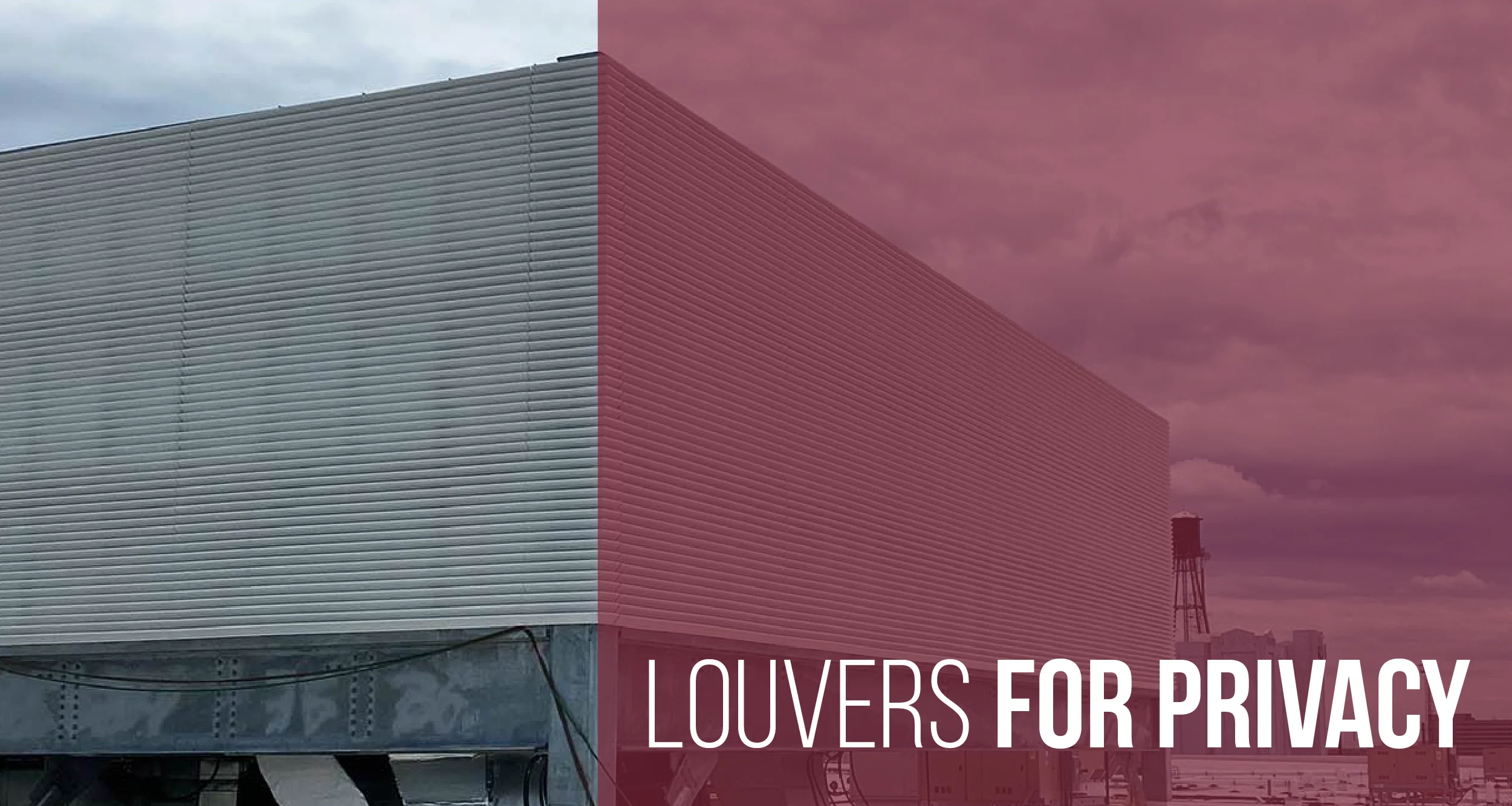Block sight lines and establish a secluded area with louvers and screens. Learn more about these privacy-centric assemblies on the MCDLG Newsstand.
The Importance of Privacy
A building should be designed to meet the needs of its occupants. We like to draw attention to the beautiful features and focus on the aesthetically pleasing aspects of our buildings, but there will also be places you want to conceal from onlookers. Privacy is an important need.
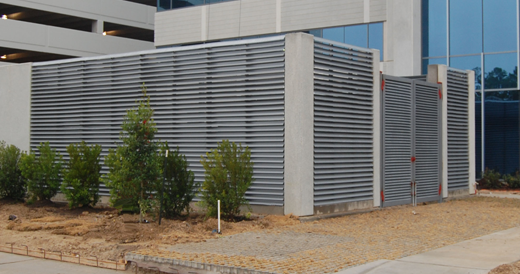 An example of a louvered fence. Louvers can create private outdoor areas, concealed from onlookers.
An example of a louvered fence. Louvers can create private outdoor areas, concealed from onlookers.
Louvers that Block Sightlines
Consider an outdoor break area. Breakrooms are typically located at the back of the building. These spaces are meant to be away from the public, so that employees can have a place to recuperate in private.
An outdoor break area would be a delightful place for employees to relax and enjoy some fresh air. Employees will want some privacy while on break. Sight proof equipment, such as louvers and screens, can prevent prying eyes from seeing into these private spaces.
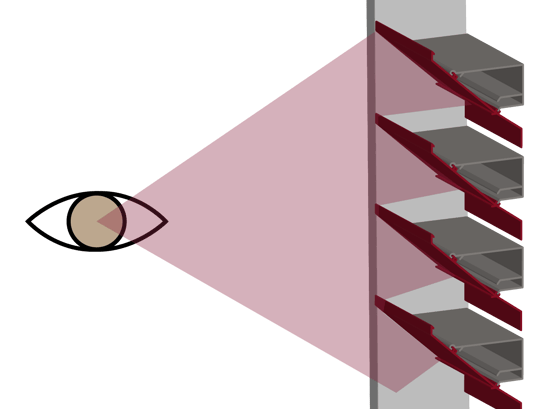
Sight proof equipment is designed to block sight lines.
Privacy can be an important aspect of your building. Consider screens and sight proof louvers from Airline Louvers. We build stationary louvers for a variety of applications. A little privacy can bring a world of comfort to the people that work in your building. Contact Airline Louvers today and let's get started.
Standard louvers have angled blades which can block sight, but it doesn’t take much to see through. The blades are set far enough apart to maintain a set amount of free area. This is good for airflow, but not for blocking sightlines. You can look at the blade from a lower angle or move closer to the louver to easily see into the area behind it.
Sight proof louvers are designed to block sightlines from any angle. These louvers are typically equipped with specialized blade profiles, like inverted chevron blades and inverted Y-shape blades.
These blades are set closer together, so that their blade profiles overlap at the free area. The peaks of the inverted chevron blades will be set closer together than standard chevron blades. This design fully blocks the sightline along the free area between the blades.
For inverted Y-shape blades, the tail of the bottom Y blade will sit close to the crook of the top Y. This overlap conceals the area behind the louver, like the inverted chevron blades. Sight proof louvers are designed for ventilation openings that lead to areas that require concealment.
Air will still pass through the louver, while the view to the interior is fully obscured by the blades. They are not designed for air performance or for rejecting rainwater.
Designing Louvers for Privacy
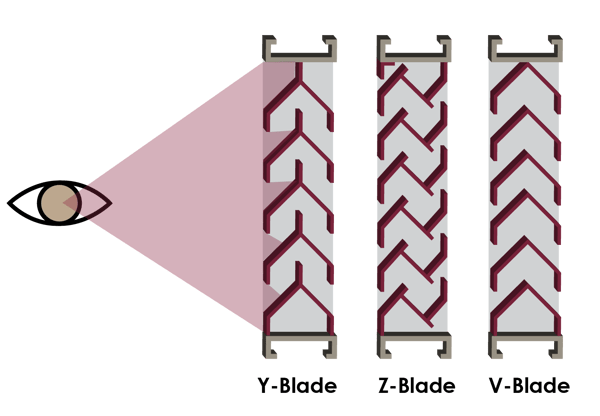
Sight proof blades are set close together, so that they block sightlines through the louver.
These louvers may receive AMCA ratings for Air Performance and Water Penetration, but they are designed for concealment. Always check the performance data on the louver’s submittal to determine if the unit works for you. All louvers will provide some concealment.
Blade profiles will typically overlap to block rainfall, such as louvers with chevron blades. Sight proof louvers are specifically designed to block sight lines from multiple angles. If privacy is your chief concern, then use a sight proof louver for the application.
Let’s say you’re ready to create that outdoor break area. You would need an assembly that can cover a large area. Sight proof louvers will have options for large openings, but you would need something that will stretch across the perimeter of an area. You will need louver screens.
At MCDLG, we call them vision screens, but they can go by many different names. Vision screens are large assemblies consisting of several panels that are joined together at the corners of the perimeter. Each panel consists of several louver blades designed to block sightlines.
Vision screen blades are typically horizontal straight blades, with either standard or inverted angles. The blades will be closely spaced so that the blade profiles nearly overlap.
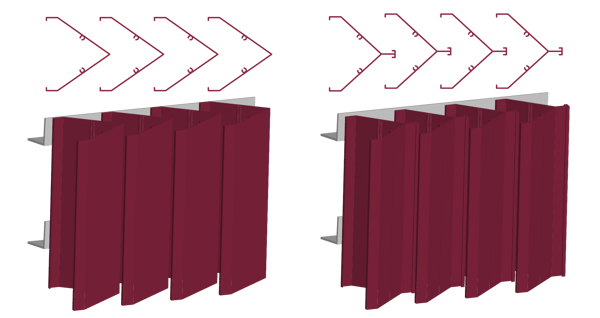
Vision screens are typically built with a continuous line, so that the blade profiles of each panel are uninterrupted across each side of the assembly. These panels use vertical blade supports to hold the blades in place, without a frame, to maintain the continuous line from panel to panel. You may also decide to have visible mullions between panels.
Corners can be joined with post caps or miter welds to achieve the desired look. Mitered corners will look like a natural joining of two panels, while post corners create a nice vertical division between sides.
Vision screens are highly customizable, so that each screen fits the application and the overall aesthetic of the project. Check out "Style with Louvers" for more ways to turn louvers into works of art.
Louvers as Equipment Screens
Large HVAC units are often mounted on the roof, feeding air into tall buildings from above. This heavy equipment may disrupt the aesthetic of your building. Equipment screens are vision screens designed to conceal this equipment on the roof of a building.
Like vision screens, equipment screens use straight blades that are closely spaced together. When installed, the equipment screen will form a perimeter around the unit, blocking sight lines from the ground to the unit. Think of it like a vision screen. The assembly will surround a private area and prevent onlookers from seeing inside.
Unlike vision screens, equipment screens are designed for installation on rooftops. Equipment screens utilize inverted straight blades, which block sightlines from below. The inverted blades will overlap when viewed from the ground, blocking any view of the equipment behind the screen.
Equipment screens have many of the same options available: post or mitered corners, continuous line panels, and custom blade spacing.
For more on louvers, check out these Newsstand articles:
- The Condenser - Mullions, Dividing Lines
- Louver Aesthetics - Form, Shape, Color
- Seven Specialty Applications for Louvers
Do you have a question on something we haven't covered here? Or maybe you need help from industry experts? MCDLG can help. Click the link below and let us know what you need.
.webp?width=91&height=70&name=MCDLG%20Logo%20(Resize).webp)
